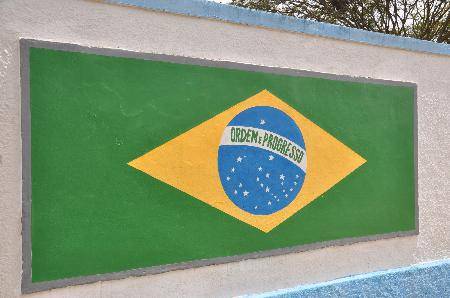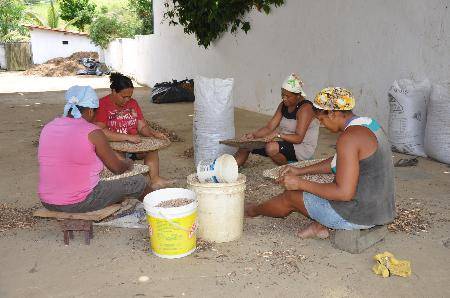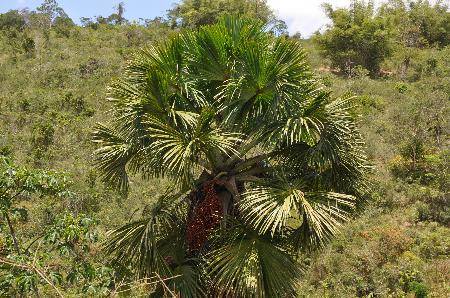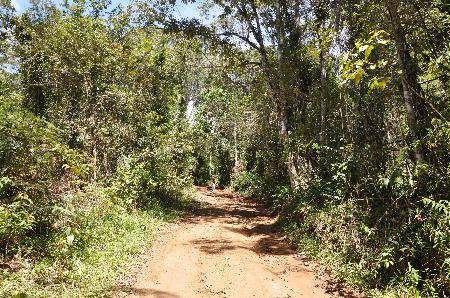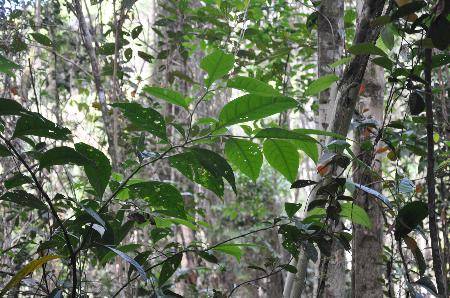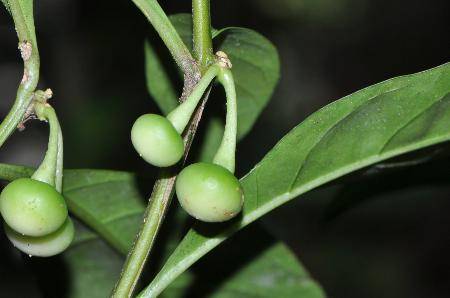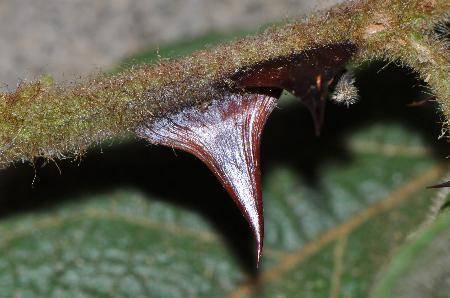After our fantastic day in Serra da Jibóia we decided to go west to the small bit of protected forest in Serra do Timbo, where Lynn had been in 2009 and seen the very narrowly distributed and quite peculiar genus Heteranthia (PDF 103KB), long thought to not be a member of the Solanaceae. In fact it is a perfectly good member of the family, as Lynn has shown using DNA sequencing and phylogenetic reconstruction.
First we had to go into the small town of Amargosa to check in with the NGO who manage the land. They were a bit discouraging - there hadn’t been anyone up there for ages and there were no trails, and lots of roads. But we thought, what could the problem be? We have our GPS…and the coordinates of Lynn’s previous collection…what can possibly go wrong?
I love the Brazilian flag – what I didn’t know until now was that the stars represent the state capitals, only one of which (Amapá) is north of the equator – the banner says “Ordem e Progreso” (Order and Progress).
In Amargosa we were given a note and a rough map – the note to hand to the manager of the huge farm Fazenda do Timbo, in which the forest patch sits, the map to help us find it. We duly checked in at the farm, where the manager was out, but we spoke to one of his deputies and all was well.
These women were separating beans from the bits of husk and dirt left behind from shelling – all by hand. In the house next door was a huge skip-sized container full of the ones they had left to do.
We could see the forest on the top of the ridges so headed up – confusingly the directions given to us at the farm were slightly different to those given to us in town – we should have had an inkling of trouble then! But up we went.
In the stream-bottom in cultivated land we saw these Mauritia palms – I usually associate these with the Amazon, it was odd to see them here; these forests in Bahia share many elements with Amazonian forests further north, but have many endemic elements as well.
Back in the ridges there was an absolute maze of tiny dirt roads – junctions everywhere you turned – incredibly confusing! None of them connected either, so we would see a road on the next ridge over that seemed to be going into forest, but had to go all the way back to the bottom to go up it… the GPS kept telling us we were a bit wrong, and we kept going away from the forest. This is when a GPS can be so irritating, always pointing in slightly the other direction; the roads were so small that none of them were on the road layer either! But at least the sun was shining...
Eventually we found one edge of the protected area we were looking for, but the GPS said the Heteranthia was to the south – we reckoned we were on one edge of the forest, but needed another road to get into the middle of it.
We did find some nice Solanum species in this forest patch, including the lovely species Leandro had just published – Solanum anisocladum (PDF 460KB). It only had tiny buds though.
We found another road in and went back up, this time into a bigger patch of forest, where we all leapt out of the car and walked up a small trail along a stream. It didn’t look right to Lynn for Heteranthia, but we were all really sick of driving around and around!
In the understory Lucas found a real prize – Solanum restingae – another of the species of section Geminata I described from Brazil in the late 1980s. Just like Solanum cordioides, it usually occurs on the coast and an enigmatic collection from this forest patch had me wondering. I hadn’t expected to find it in this spot though, the coordinates I had were some 10 kilometres to the southwest.
Solanum restingae is a small tree about 4 metres high, with the characteristic geminate (twinned) leaves of the group. I always think these plants are beautiful, but I guess it is an acquired taste.
Solanum restingae was the other target for the day – in herbaria people had been identifying specimens of any Solanum from Bahia with non-hairy leaves and stems as this, while it seemed there might be two very similar species. One of these we had collected at Fazenda Duas Barras – it was a little tiny forest shrub with green fruits, but the leaf bases and stems looked different to me in the herbarium. Seeing true Solanum restingae in the field would confirm or deny my suspicions about these – were they two species or just one variable one?
Our Fazenda Duas Barras specimen is a new species! It was also exciting to see Solanum restingae from the field – another one I can now imagine as a real plant and not just herbarium sheets.
Solanum restingae was indeed quite different – so our Fazenda Duas Barras is a new species! The differences between the two species are many, including:
- Tree versus small shrub
- Stems winged versus smooth
- Leaves tapering at the base versus slightly heart-shaped
- Calyx tiny and almost absent versus long and swollen
So now I will just need to be sure I can see these on herbarium specimens, and write an identification guide that allows others to do so as well!
Solanum restingae is a good example of the pitfalls of naming new species… when I first named it this species was known from only two or three collections from the very particular coastal habitat in Bahia called “restinga arborea” – so I named it for what I thought at the time was its specialised habitat. Oh, how wrong can one be!! Solanum is such a big genus that new names are hard to come up with – most obvious epithets referring to the plant form or colour have already been used. So – Solanum restingae is a misnomer, it certainly does not only occur in the restinga. It is the oldest name, however, so we will have to live with it – and besides it rather trips off the tongue, so is not so bad.
Habitats under pressure
The new collecting that has been done in these Atlantic forests of southern Brazil has really increased our knowledge of the diversity of the plants in them – so species we thought were highly restricted a decade or so ago are now known from more collections so we have a better idea of their ecology and habitat preferences.
Still, these deep forest solanums like Solanum restingae have less and less habitat all the time as the forest is cut down, so small protected areas like that in the Serra do Timbo are essential for their survival. Once they might have occurred all the way from the coast inland where now there are only agricultural fields; we are unlikely to ever know for sure, our human footprint on the landscape is so big.
Exhausted from the to-and-fro driving, but pleased to have found at least one exciting thing, we gave up on Heteranthia for this year. Maybe another time…all in all not a bad last day in the field for a while.
On our way out we stopped for one last Solanum – and collected a prickly monster from the roadside with dark burgundy colored thorns about 1cm wide at the base. In the key it comes out as Solanum jabrense, described by our colleague Fatima Agra – but that species is supposed to have straight prickles, not these flattened monsters. We will have to save a piece for her to look at when we get back to Belo Horizonte.
Yet another mystery – another new species or just variation that hasn’t been recorded yet? Either is just fine and an increase in knowledge.
Our GPS track around the Serra do Timbo must look like spaghetti junction – it seems we went everywhere but where to find Heteranthia! Next time for sure…



